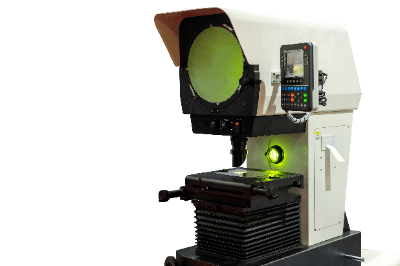What Is a Profile Projector?
 A profile projector is a device that projects a magnified image of the object to be measured onto a screen at an accurate magnification, and observes and measures the shape and dimensions from the magnified image.
A profile projector is a device that projects a magnified image of the object to be measured onto a screen at an accurate magnification, and observes and measures the shape and dimensions from the magnified image.
Since the universal projector is an optical measuring instrument, it enables non-contact measurement and observation of the object to be measured without damaging the object. In addition, since the measurement is made by magnifying and projecting the image on a screen, multiple people can observe the image simultaneously. The advantage of this system is that it is easy to handle.
The most common screen size is 300~500 mm, but there are also some larger products with a screen size of 1,000 mm or more. Universal projectors are still in strong demand today because of their simple structure, low cost, and the fact that they can be installed in any location.
Uses of Profile Projectors
Profile projectors are mainly used in industrial production and quality assurance. They can be used immediately after turning on the power and are convenient for quality checks on the production line because of the magnified projection on the screen.
It is used to observe the contours and measure the dimensions of machined parts, and is also useful for comparative measurements using templates. The main objects to be measured are metal parts and resin molded products, but since it is an optical measuring instrument, it can also be used to observe objects that transmit light, such as living organisms. Some models are equipped with a simple surface observation function, so they can be used in a wide range of situations and fields.
Principle of Profile Projectors
A projector projects an enlarged image on a screen by passing a shadow created by transmitting light through a lens onto the object to be measured. Therefore, the part of the stage where the object to be measured is placed must be transparent and have high transmittance so that light can pass through it, such as glass.
Telecentric optics are used in the optical system for transillumination. The advantage of telecentric optics is that the image is only blurred even when out of focus and does not change in size.
Note that profile projectors use a single lens unit to perform the process from focusing to image formation, so the size and magnification of the lens naturally determines the distance from the focal point to the screen. It should be noted that there is a limit to the size of the screen and equipment.
Other Information on Profile Projectors
Error Factors With a Profile Projector
Typical error factors when measuring with a profile projector are measurement error and magnification error. Profile projectors are basically used for measurement by visually aligning the edges projected on the screen, so alignment errors caused by visual inspection and distortions caused by the operator’s habits cannot be ignored.
Errors caused by the parallelism of the XY stage and the inclination of the object to be measured, or errors caused by the profile projector itself or the object to be measured not being level, can also be a cause of measurement errors. In addition, due to the measurement principle of the profile projector, the light from the light source to the screen is not parallel.
Therefore, if the mirror mounted inside is tilted, there will be a difference in magnification between the center and the edge of the screen. This is called magnification error, and if the magnification error becomes too large, the reliability of measurement values at points off the center of the optical axis will decrease.